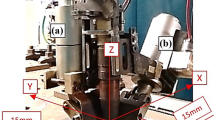Abstract
CO2 blended with Ar is the most common shielding gas used for short-circuit gas metal arc welding (GMAW). There has been some technical knowledge devised from the process application over the years (personal opinion and results from practice) on the selection of the gas blend composition. However, there is still a lack of more scientific data to explain the performance of the mixtures. This paper presents a systematic study of the influence that CO2 content in mixture with Argon has on the operational performance of the short-circuit GMAW. The objectives of this study were to describe, to quantify and to explain the alterations in the metal transfer behavior, spatter generation, weld bead geometry and bead finish due to the different CO2 contents in the shielding gas. Carbon steel plates were welded in adequate parametric conditions for each CO2 + Ar shielding gas composition (CO2 ranging from 2 to 100 %). These parametric conditions were found by applying a metal transfer regularity index over welds carried out at different voltage settings for each gas blend. A target of 130 A was applied as base for comparison. Laser shadowgraphy with high-speed filming and current and voltage oscillograms were used as analysis tools. The results showed (and confirmed) that the increase of the CO2 content deteriorates metal transfer regularity, leading to excessive spatter generation and uneven bead appearance, but increases the penetration and the fusion area of the weld beads and improves bead convexity. In general, the CO2 content should neither be lower than 10 % (unless for thin plates) nor higher than 30 %.












Similar content being viewed by others
References
Zielinska S, Pellerin K, Dzierzega K, Musiol F, Valensia C, de Izarra, Briand F (2008) Gas influence on the arc shape in MIG–MAG welding. Eur Phys J AP 43(1):111–122
Stenbacka N, Persson KA (1989) Shielding gases for gas metal arc welding. Weld J 68(11):41–48
Soderstrom E, Mendez PF (2008) Metal transfer during GMAW with thin electrodes. Weld J 87(5):124s–133
Hermans MJM, den Ouden G (1999) Process behavior and stability in short circuit gas metal arc welding. Weld J 78(4):137–141
Kim Y-S, Eagar TW (1993) Analysis of metal transfer in gas metal arc welding. Weld J 72(1):269–278
Rhee S, Kannatey-Asibu E (1992) Observation of metal transfer during gas metal arc-welding. Weld J 71(3):381
JACOBSEN N (1992) Monopulse investigation of drop detachment in pulsed gas metal arc welding. J Phys D Appl Phys 25(5):783. doi:10.1088/0022-3727/25/5/007
AWS (1987) Welding handbook—volume 1: welding technology. American Welding Society, USA, pp 50–53
Stappon GWF, Lyttle KA (2007) 7 effects of shielding gas, Practical Welding Today http://www.thefabricator.com/article/arcwelding/7-effects-of-shielding-gas
Scotti A, Ponomarev V (2008) MIG/MAG Welding: better understanding, higher performance. Artliber Editora Ltda, SP, pp 153–155 (in Portuguese)
Scotti A, Rodrigues CEAL (2009) Determination of momentum as a mean of quantifying the mechanical energy delivered by droplets during MIG/MAG welding. Eur Phys J AP 45(1):11201. doi:10.1051/epjap:2008196
JEFFUS L (2004) Welding: principles and applications, 5th edn. Thomson Delmar Learning, NY, pp 253–255
Klaric S, Samardzic I, Kladaric I (2008) MAG welding process – analysis of welding parameter influence on joint geometry, 12th International Research/Expert Conference Trends in the Development of Machinery and Associated Technology, Istanbul, Turkey, University of Zenica p. 185–188
Murray PE, Scotti A (1999) Depth of penetration in GMAW. Sci Technol Weld Join 4(2):112–117
Rezende GMC, Liskevych O, Vilarinho OLO, Scotti A (2011) A criterion to determine voltage setting in short-circuit GMAW. Soldagem Inspeção 16(2):98–103, in Portuguese
Scotti A, Rezende GMC, Liskevych O (2011) Measurement of Metal Transfer Regularity as a means of Selecting Parameters in GMAW with Short-Circuiting, In: IIIW Commission XII/SG 212 Intermediate Meeting, Trollhättan. IIIW Commission XII/SG 212 Intermediate Meeting. Paris: IIW p. 1–10
Baixo CEI, Dutra JC (2009) Effect of shielding gas and transfer mode on the application of 625 alloy in carbon steel. Soldagem Inspeção 14(4):21–24 (in Portuguese)
Meneses VA, Scotti A (2014) Governing parameters affecting fume generation in short-circuit MAG welding. Welding World 58(3):367–376 ISSN 0043–2288, doi:10.1007/s40194-014-0122-2
Meneses VA, Gomes JFP, Scotti A (2014) The effect of metal transfer stability (spattering) on fume generation, morphology and composition in short-circuit MAG welding. J Mater Process Technol 214:1388–1397. doi:10.1016/j.jmatprotec.2014.02.012
Acknowledgments
The authors wish to thank all team members of the welding group Laprosolda (Center for Research and Development of Welding Processes) of the Federal University of Uberlandia, Brazil, for infrastructure, support and advice. They also give thanks to the Brazilian organizations for Research and Development, Fapemig (through project TEC 604/2005), CNPq (for the scholarships) and Capes (through the program PROEX)
Author information
Authors and Affiliations
Corresponding author
Additional information
Doc. IIW-2508, recommended for publication by Commission XII “Arc Welding Processes and Production Systems.”
Rights and permissions
About this article
Cite this article
Liskevych, O., Scotti, A. Influence of the CO2 content on operational performance of short-circuit GMAW. Weld World 59, 217–224 (2015). https://doi.org/10.1007/s40194-014-0196-x
Received:
Accepted:
Published:
Issue Date:
DOI: https://doi.org/10.1007/s40194-014-0196-x



